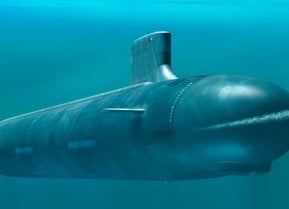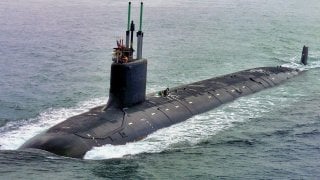The Stunning Virginia-Class Block V: The Best Submarine Ever?
The first Block V Virginia-class submarine is expected to hit the waters no later than 2028. As tensions between Beijing and Washington continue to ramp up, the introduction of this super-sub variant will undoubtedly play a key role in the Navy’s strategic endeavors.
Meet the Virginia-Class Block V Submarine: Some of the buzzwords that come to mind when considering the U.S. Navy’s Virginia-class submarines are stealth, endurance, prowess, and versatility. This powerful SSN platform has remained a mainstay of the service since the first series was introduced more than two decades ago. As fast-attack ships, the Virginia-class boats can operate in a variety of both littoral and open-ocean missions and are used for intelligence gathering, reconnaissance, surveillance, and anti-warfare among others.
While each Virginia-class variant is widely respected among analysts and military buffs alike, the latest iteration is considered to be the best fast-attack SSN of its kind ever to hit the waters. The Virginia-class Block V boats play a leading role in helping to deter U.S. adversaries from the sea.
A History Of The Virginia-Class SSNs
Back in the early 1990s before the full collapse of the Soviet Union, the Navy pressed to develop and produce more formidable ships. Throughout the peak of the Cold War, nuclear-powered submarines played a significant role as sea-based ballistic missile launch platforms. Specifically on the U.S. front, submarines aided the North Atlantic Treaty Organization’s (NATO) anti-submarine strategy, helping member states observe and track the Soviet’s nuclear-armed submarines as they headed to the Atlantic. Under the codename Centurion, the U.S. Navy initiated a program to design replacement ships for aging platforms.
The Virginia-Class Ships Were The Navy’s Cost-Friendly Replacement SSN Series
At this time, the Navy’s newer Seawolf-class submarines were breaking the bank so to speak.
In fact, the cost of this class was estimated to be more than $33 billion, making it the most pricey naval building program to ever exist. In 1991, this number was one-quarter of the Navy’s construction budget. By the time the Soviet Union dissolved, however, the need for such expensive submarines was questioned. Ultimately, the class was trimmed to be made up of just three books that cost around $7 billion, meaning over $2 million billion per submarine. Without the extra Seawolf-class ships though, the Navy still needed to replace its 51 Los Angeles-class ships. The service turned to the more cost-friendly Virginia-class alternatives instead.
The Virginia-class boats were notably the first submarines in the U.S. Navy to be developed with aids such as the 3D visualization technology CATIA, which comprises computer-aided engineering, computer-aided manufacturing, computer-aided design, and product lifecycle management. Despite the use of this cutting-edge technology, issues regarding the class’ design resulted in production delays. Two manufacturers, Newport News Shipbuilding and Electric Boat (a division of General Dynamics), have been the drivers behind the Virginia-class ships’ production since the introduction of the platform as they are the only facilities with the capacity to construct nuclear-powered SSNs.
The Block V Variants Will Blow Its Counterparts Out Of The Water
Today, 21 Virginia-class submarines have been commissioned. The majority of these submarines are from the earlier Blocks I-III classes and only three Block IV ships are in service today. All Virginia-class vessels measure about 377 feet long and can displace 8,000 tons. The hefty ships can travel at speeds around 25 knots, powered by nuclear energy. The latest Block V iteration is expected to be the most capable series in the Virginia-class to date.

Electric Boat president Kevin Graney asserted that the new model will be able to perform seabed warfare capabilities vis-a-vis its new Virginia Payload Module. This VPM will extend the submarine’s armament-carrying capabilities. An additional 84-foot section will specifically be able to accommodate the four new vertical launch tubes that will be fitted to the SSN. The Virginia-class Block V submarines will also feature the latest Tomahawk Block V missiles which will enable an anti-ship capability to the existing land-attack mode.
Naval News also detailed that some rumors indicate new hypersonic boost-glide vehicles could be incorporated in each VLS, “Because the Block Vs have more VLS slots it seems natural that they will be among the first submarines to carry the hypersonic missiles. With a total of 6 VLS tubes they could carry a mixed load of, perhaps, 12 hypersonic missiles (3 in each of the aft 4 tubes) and 12 Tomahawks in the forward tubes.”

Currently, the U.S. does already possess a submarine equipped with sea-bed abilities. The Seawolf-class USS Jimmy Carter (SSN-23) is a specially modified SSN in this class. With the introduction of the newest Virginia-class Block V ships, however, the Jimmy Carter must make room for a super-sub also able to conduct seabed warfare operations.
The first Block V Virginia-class submarine is expected to hit the waters no later than 2028. As tensions between Beijing and Washington continue to ramp up, the introduction of this super-sub variant will undoubtedly play a key role in the Navy’s strategic endeavors.
About the Author
Maya Carlin is an analyst with the Center for Security Policy and a former Anna Sobol Levy Fellow at IDC Herzliya in Israel. She has by-lines in many publications, including The National Interest, Jerusalem Post, and Times of Israel. You can follow her on Twitter: @MayaCarlin.


